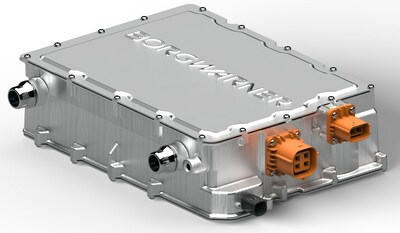BorgWarner to Supply Bi-Directional 800-Volt Onboard Charger to Major North American OEM
- None.
- None.
Insights
Analyzing...
- 800V Onboard Battery Charger (OBC) to be used on OEM's premium battery electric vehicle (BEV) platforms
- Leverages BorgWarner's silicon carbide (SiC) technology and bi-directional vehicle-to-load (V2L) feature
- Offers various degrees of power including 19.2kW single phase and 22kW three phase operation
- Marks BorgWarner's first Onboard Charger win in
North America
"This is a big accomplishment for the team at BorgWarner, highlighting our first OBC win with this OEM and marks the first OBC win in
BorgWarner's OBC technology is installed in electric vehicles to convert alternating current (AC) from the power grid to direct current (DC) to charge batteries. The OBC is capable of powers ranging from 19.2kW single-phase operation to 22kW three-phase operation. The 19.2kW power level uses two power lines for a single-phase grid connection, which is unique to the U.S. market. The 22kW power level uses a three-phase grid connection and is intended for use in the European market. The 19.2kW single-phase charger is currently the only one of its kind to be introduced into the U.S. market.
The OBC incorporates a bi-directional vehicle-to-load (V2L) operating mode that enables users to use the vehicle battery pack to charge various standalone applications, which is an increasingly desired feature within the industry. Additionally, both the charger hardware and software are designed and produced by BorgWarner.
About BorgWarner
For more than 130 years, BorgWarner has been a transformative global product leader bringing successful mobility innovation to market. Today, we're accelerating the world's transition to eMobility – to help build a cleaner, healthier, safer future for all.
Forward Looking Statements: This release may contain forward-looking statements as contemplated by the 1995 Private Securities Litigation Reform Act that are based on management's current outlook, expectations, estimates and projections. Words such as "anticipates," "believes," "continues," "could," "designed," "effect," "estimates," "evaluates," "expects," "forecasts," "goal," "guidance," "initiative," "intends," "may," "outlook," "plans," "potential," "predicts," "project," "pursue," "seek," "should ," "target," "when," "will," "would," and variations of such words and similar are intended to identify such forward-looking statements. Further, all statements, other than statements of historical fact, contained or incorporated by reference in this release that we expect or anticipate will or may occur in the future regarding our financial position, business strategy and measures to implement that strategy, including changes to operations, competitive strengths, goals, expansion and growth of our business and operations, plans, references to future success and other such matters, are forward-looking statements. Accounting estimates, such as those described under the heading "Critical Accounting Policies and Estimates" in Item 7 of our most recently filed Annual Report on Form 10-K ("Form 10-K"), are inherently forward-looking. All forward-looking statements are based on assumptions and analyses made by us in light of our experience and our perception of historical trends, current conditions and expected future developments, as well as other factors we believe are appropriate under the circumstances. Forward-looking statements are not guarantees of performance, and the Company's actual results may differ materially from those expressed, projected or implied in or by the forward-looking statements.
You should not place undue reliance on these forward-looking statements, which speak only as of the date of this release. Forward-looking statements are subject to risks and uncertainties, many of which are difficult to predict and generally beyond our control, that could cause actual results to differ materially from those expressed, projected or implied in or by the forward-looking statements. These risks and uncertainties, among others, include: supply disruptions impacting us or our customers, such as the current shortage of semiconductor chips that has impacted original equipment manufacturer ("OEM") customers and their suppliers, including us; commodity availability and pricing, and an inability to achieve expected levels of recoverability in commercial negotiations with customers concerning these costs; competitive challenges from existing and new competitors including OEM customers; the challenges associated with rapidly changing technologies, particularly as relates to electric vehicles, and our ability to innovate in response; uncertainties regarding the extent and duration of impacts of matters associated with the COVID 19/coronavirus pandemic, including additional production disruptions; the difficulty in forecasting demand for electric vehicles and our electric vehicles revenue growth; potential disruptions in the global economy caused by
![]() View original content to download multimedia:https://www.prnewswire.com/news-releases/borgwarner-to-supply-bi-directional-800-volt-onboard-charger-to-major-north-american-oem-301975441.html
View original content to download multimedia:https://www.prnewswire.com/news-releases/borgwarner-to-supply-bi-directional-800-volt-onboard-charger-to-major-north-american-oem-301975441.html
SOURCE BorgWarner









